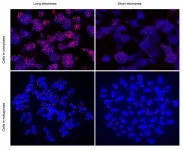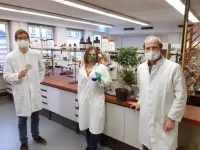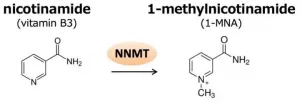Unveiling the double origin of cosmic dust in the distant Universe
An international team of researchers develops a new method for the study of large, massive, dusty galaxies and sheds new light on the physical processes involved in the production of dust in these 'giants'
2021-01-11
(Press-News.org) Two billion years after the Big Bang, the Universe was still very young. However, thousands of huge galaxies, rich in stars and dust, were already formed. An international study, led by SISSA - Scuola Internazionale Superiore di Studi Avanzati, now explains how this was possible. Scientists combined observational and theoretical methods to identify the physical processes behind their evolution and, for the first time, found evidence for a rapid growth of dust due to a high concentration of metals in the distant Universe. The study, published in Astronomy&Astrophysics, offers a new approach to investigate the evolutionary phase of massive objects.
Since their initial discovery 20 years ago, very distant and massive galaxies that form prodigious amount of young stars - so-called dusty (star-forming) galaxies - represent a serious challenge for astronomers: "On one hand, they are difficult to detect because they reside in dense regions of the distant Universe and contain dusty particles which absorb most of the optical light radiated by young stars", explains Darko Donevski, postdoctoral fellow at SISSA. "On the other hand, many of these dusty 'giants' have been formed when the Universe was very young, sometimes even less than 1 billion years-old, and scientists have been wondering how could such large amount of dust have been produced so early in time".
The study of these exotic objects is now possible thanks to the Atacama Large Millimeter/submillimeter Array (ALMA). This interferometer of 66 telescopes in the Atacama Desert of northern Chile is able to detect the infrared light which penetrates the dusty clouds, revealing the presence of newly forming stars. However, the origin of large amount of dust at early cosmic time is still an open question to astronomers. "Throughout many years scientists thought that production of cosmic dust was exclusively due to supernovae explosion. However, recent theoretical works suggest that dust can also grow through collisions of particles of cold, metal-rich gas which fills the galaxies," explains the researcher.
An international team of researchers from institutions based in Europe, US, Canada and South Africa, led by Donevski, combined observational and theoretical methods to study 300 distant, dusty galaxies in order to unveil the origin of these "Giants". In particular, they inferred the physical properties of these dusty galaxies by fitting their spectral energy distributions. "We found a huge amount of dust mass in most of our galaxies. Our estimates showed that supernovae explosions could not be responsible for all of it and a part had to be produced through particle collisions in the gaseous metal-rich environment around massive stars, as previously supposed by theoretical models" says Donevski. "This is the first time that observational data support the existence of both production mechanisms."
Scientists also looked at dust to star mass ratio over time to study how efficiently galaxies create and destroy dust during their evolution. "This allowed us to identify dust life cycle in two different populations of galaxies: normal, so-called 'main-sequence', galaxies, which are slowly evolving, and more extreme, rapidly evolving galaxies, called 'starbursts'", said Lara Pantoni, PhD student at SISSA, who developed the analytic model used for data interpretation. The model shows the great potential in describing differences in these two groups of observed galaxies. "Interestingly, we also showed that irrespective of their distance, stellar mass or size, compact 'starburst' galaxies always have dust-to-stellar mass ratio higher than the normal galaxies."
To fully evaluate the observational findings, the team of astronomers also confronted their data with the state-of-the-art galaxy simulations. They used SIMBA, a new suite that simulates the formation and evolution of millions of galaxies since the beginning of the Universe to present time, tracking all their physical properties, including dust mass. "Up to now, theoretical models had problems in matching both galaxy dust and stellar properties simultaneously. However, our new cosmological simulation suite, SIMBA, could reproduce most of the observed data," explains Desika Narayanan, professor of astronomy at the University of Florida and member of the DAWN institute in Copenhagen.
"Our study shows that dust production in 'giants' is dominated by very rapid growth of particles through their collisions with gas. Thus, it provides the first strong proof that dust formation occurs both during stars death and in the space between these massive stars, as assumed from theoretical studies," concludes Donevski. "Moreover, it offers a new mixed approach to investigate the evolution of massive objects in the distant Universe that will be tested with future space telescopes such as the James Webb Space Telescope."
INFORMATION:
Video Interview with D. Donevski:
https://bit.ly/3qc60WK
ELSE PRESS RELEASES FROM THIS DATE:
2021-01-11
Patients with severe COVID-19 disease have significantly shorter telomeres, according to a study conducted by researchers at the Spanish National Cancer Research Centre (CNIO) in collaboration with the COVID-IFEMA Field Hospital, published in the journal Aging. The study, led by Maria A. Blasco and whose first authors are Raúl Sánchez and Ana Guío-Carrión, postulates that telomere shortening as a consequence of the viral infection impedes tissue regeneration and that this is why a significant number of patients suffer prolonged sequelae.
Blasco was already developing a therapy to regenerate lung tissue in pulmonary fibrosis patients; she now believes that this treatment -which should still take at least a year and a half to become available- ...
2021-01-11
NEW YORK, NY (Jan. 11, 2021)--A new study has found that up to 20% of glioblastomas--an aggressive brain cancer--are fueled by overactive mitochondria and may be treatable with drugs currently in clinical trials.
Mitochondria are responsible for creating the energy that fuels all cells. Though they are usually less efficient at producing energy in cancer, tumor cells in this newly identified type of glioblastoma rely on the extra energy provided by overactive mitochondria to survive.
The study, by cancer scientists at Columbia University's Vagelos College ...
2021-01-11
For some years, an active substance from the leaves of an ornamental plant has been regarded as a possible forerunner of a new group of potent drugs. So far, however, it has been very laborious to manufacture it in large quantities. That could now change: Researchers at the University of Bonn (Germany) have identified a bacterium that produces the substance and can also be easily cultivated in the laboratory. The results are published in the journal Nature Communications.
The coralberry currently once again adorns many living rooms: In winter it bears bright red fruits, which make it a popular ornamental plant at this time of year. For pharmacists, however, it is interesting for a different reason: It contains ...
2021-01-11
CHAMPAIGN, Ill. -- For years, researchers have worked to repurpose excess atmospheric carbon dioxide into new chemicals, fuels and other products traditionally made from hydrocarbons harvested from fossil fuels. The recent push to mitigate the climactic effects of greenhouse gases in the atmosphere has chemists on their toes to find the most efficient means possible. A new study introduces an electrochemical reaction, enhanced by polymers, to improve CO2-to-ethylene conversion efficiency over previous attempts.
The results of the study led by University of Illinois Urbana-Champaign chemistry ...
2021-01-11
Metabolites are organic molecules that take part in or are created during the biochemical reactions constantly taking place in an organism. For the human body, more than 110,000 metabolites have been identified. Metabolites play a role in metabolic syndrome, which is the situation in which several medical conditions occur simultaneously; the conditions include obesity, high blood pressure and high blood sugar. Metabolic syndrome is associated with a higher risk of developing cardiovascular disease, type-2 diabetes and different kinds of cancer. The presence of certain metabolites can be an indicator for particular pathological ...
2021-01-11
This most likely explains the augmented response of the immune system and the more severe disease progression. However, certain hypertension-reducing drugs known as ACE inhibitors can have a beneficial effect. They not only lower blood pressure, but also counteract immune hyperactivation. The scientists have now published their findings in the journal Nature Biotechnology.
More than one billion people worldwide suffer from high blood pressure, or hypertension. Of the more than 75 million people around the world who have become infected with the SARS-CoV-2 virus worldwide so far, more than 16 million also have hypertension. These patients are more likely to become severely ill, which in turn results in an increased ...
2021-01-11
NEW YORK, NY (Jan. 11, 2021)--Thousands of different genetic mutations have been implicated in cancer, but a new analysis of almost 10,000 patients found that regardless of the cancer's origin, tumors could be stratified in only 112 subtypes and that, within each subtype, the Master Regulator proteins that control the cancer's transcriptional state were virtually identical, independent of the specific genetic mutations of each patient.
The study, published Jan. 11 in Cell, confirms that Master Regulators provide the molecular logic that integrates the effect ...
2021-01-11
Philadelphia, January 11, 2021 - Children and adolescents with a family history of suicide attempts have lower executive functioning, shorter attention spans, and poorer language reasoning than those without a family history, according to a new study by researchers from the Lifespan Brain Institute (LiBI) of Children's Hospital of Philadelphia (CHOP) and the University of Pennsylvania. The study is the largest to date to examine the neurocognitive functioning of youth who have a biological relative who made a suicide attempt.
The findings, which were first published online last March, were published in the January 2021 edition of The Journal of Child Psychology and Psychiatry.
Researchers looked at 3,507 youth aged 8 to 21. Of those, ...
2021-01-11
Russian researchers have proposed a new method for synthesizing high-quality graphene nanoribbons -- a material with potential for applications in flexible electronics, solar cells, LEDs, lasers, and more. Presented in The Journal of Physical Chemistry C, the original approach to chemical vapor deposition, offers a higher yield at a lower cost, compared with the currently used nanoribbon self-assembly on noble metal substrates.
Silicon-based electronics are steadily approaching their limits, and one wonders which material could give our devices the next big push. Graphene, the 2D sheet of carbon atoms, comes to mind but for all its celebrated electronic properties, it does not have what it takes: Unlike silicon, graphene does not have the ability to switch between ...
2021-01-11
CHICAGO (January 11, 2021): A new study of liver transplant centers confirms that non-Hispanic white patients get placed on liver transplant waitlists at disproportionately higher rates than non-Hispanic Black patients. However, researchers went a step further as they identified key reasons for that disparity: disproportionate access to private health insurance, travel distance to transplant centers, and a potential lack of knowledge among both practitioners and patients about available options. The study was selected for the 2020 Southern Surgical Association Program and published as an "article in press" on the website of the Journal of the American College of Surgeons in advance of print.
"We found that the Black population was underrepresented at the vast majority of centers, ...
LAST 30 PRESS RELEASES:
[Press-News.org] Unveiling the double origin of cosmic dust in the distant Universe
An international team of researchers develops a new method for the study of large, massive, dusty galaxies and sheds new light on the physical processes involved in the production of dust in these 'giants'





